 |
||
|
||
| ||
About boards and BOARDSMicro-Star, as any other large manufacturer, tries to offer as wide range of products as possible so that they may suit both OEM companies, smaller PC assemblers and those users who prefer to build their own unique machines. In the latter case a board must be unusual and extraordinary both inwardly and outwardly. MSI produces boards which has an almost optimal balance between a beautiful appearance, an internal substance and good hardware and software sets. Today some manufacturers just paint their boards to make them exclusive and sell at a very high price. MSI isn't keen on such things. That is why we introduce you our today's hero with great pleasure: MSI K7Turbo-R Limited Edition mainboard. Specification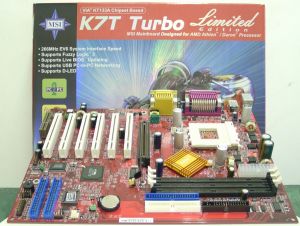
Impressions The vinous motherboard has a wealth of various functions, the most notable being the IDE RAID, which with more than one HDD with IDE interface helps to increase considerably the speed of operation of the disc subsystem (Stripe mode) or to reduce a probability of data losses (Mirror mode). Besides, this board is equipped with a series of proprietary technologies such as D-LED, Fuzzy Logic III, Live BIOS, and PC-2-PC. The former allows backtracing the process of passing by the system of the POST procedure (Power On Self Test) when a bracket with one USB connector and 4 LEDS is connected to the rear panel of the computer, and allows diagnosing an out-of-order element when loading problems occur. The Fuzzy Logic III helps you to change the CPU frequency from the Windows. This program can implement these instructions both in auto and in manual modes. But with the BIOS you will achieve more impressing results than those obtained with this utility. The auto mode from FuzzyLogic helps, however, to set a well serviceable mode without a user's interference. That is why an overclocking becomes available for a wider range of users.  The Live BIOS allows making update of the BIOS by just connecting the Internet with the help of the Explorer 4.01 and higher. The program will automatically check a new version and will update the chip if necessary. If the operating system hangs, the contents of the BIOS chip can be damaged. The "Limited Edition" board differs from a basic model in a wider set of functions. The main distinguishing feature is the design of the board, box and documentation.  On the box you can see an impressing hologram.
Two booklets make the User Manual. The first one describes the board
and answers all questions on installation in English. In the second
one you will find the information about the jumpers in 9 languages.
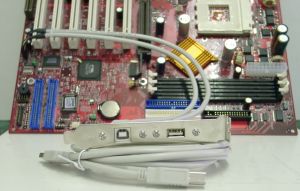 Now let's talk about the PC-2-PC connection with a USB cable. The board is supplied with a cable and a bracket with two connectors on the rear panel of the computer. One of the connectors is standard. The other is a so called "Type B" one. It must be connected with a cable which has "Type A" connector on its end. When this cable is connected to another computer, the network will work at 12 Mbit. This way in the definite conditions you can create at home practically a free network. A separate booklet contains the detailed description of the IDE RAID controller. A CD, supplied with the board, contains drivers for boards, video cards etc. from MSI. Besides, there are short descriptions of all motherboards in the PDF format. The CD also contains utilities of AMI and Award for operation with the Suspend-To-Disk function and WinFlash of Award for updating BIOS from Windows. Besides, there are LiveBIOS, Fuzzy Logic 3 and PC Alert programs (the latter is the utility of monitoring of temperatures and fan speeds). It should be noted that you can't run at the same time Fuzzy Logic and PC Alert. The CD also offers MediaRing Talk program for online communication on the Internet, VNC-client and a sever for a computer remote control (for details go to http://www.orl.co.uk/vnc), and the Xteq X-Setup - an unquestionable leader among the programs for adjusting the majority of the Windows parameters. The board is also supplied with a usual bracket with 2 USB ports, a PC-2-PC bracket, 40- and 80-conductor IDE cables and an FDD cable. Now let me turn to the board. The engineers have done their best - the board won't make the computer assemblage difficult. The only drawback is the fact that IDE RAID connectors will be difficult to access in case of installation of full-size PCI cards in the last two slots. The board has four 4700 uF and two 3900 uF capacitors which make the board's operation very stable. The AGP slot is equipped with a bracket to prevent an accidental falling out of a video card from the slot. Besides, there are several jumpers, two of which control switching on/off of the IDE RAID and make a choice of its mode - RAID or UATA/100. There is also a jumper for cleaning the CMOS contents, and a jumper for setting the base processor's frequency - 100 or 133 MHz. The other settings are adjusted with the help of the BIOS Setup. The BIOS is based on the 6.00 from Award. You can change a CPU frequency up to 199 MHz in 1 MHz increments and change voltages of the core, chipset and memory. In the first case - within the range of 1.3 - 1.85 V in 0.025 V steps, in the second case - you can choose either 3.3 V or 3.45 V. In closing I want to say that the board has left very pleasant impressions as far as its design and possibilities are concerned. TestsTest system:
Performance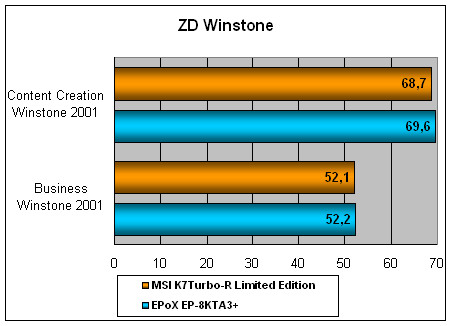 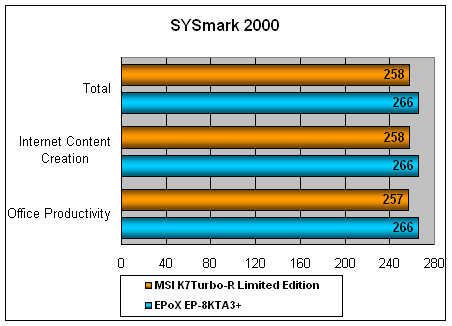 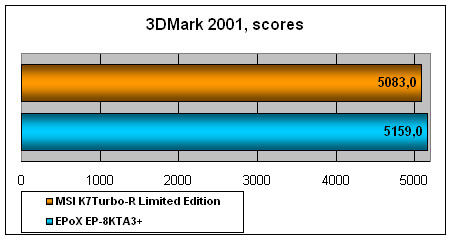 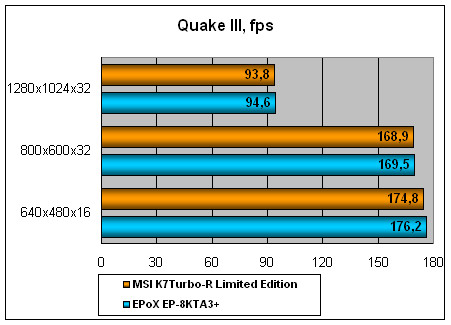  Comments:The MSI loses nearly everywhere to the EPoX 8KTA3+, regardless of the test software. But the gap is not big. This picture makes me think that it is just a reassurance of the MSI developers. It is well know that the number of settings in the BIOS depends on their desire. ConclusionThe MSI K7Turbo-R Limited Edition board has a very good design, a lot of functions, it is convenient to use and stable. The overclocking possibilities are perfect - not so many manufacturers allow lifting not only Vcore but also VIO and Vmem. Good capacitors and a bracket on the AGP slot, as well as the IDE RAID controller from Promise and not from HighPoint prove that the developers didn't try to save on this board. The software set is excellent. Apart from the standard LiveBIOS and FuzzyLogic III, you can find there VNC-client and Xteq X-Setup as well as the PC-2-PC, which allow you to create a home network quickly and painlessly, and where you can play Quake III as much as possible. Highs:
Lows:
Write a comment below. No registration needed!
|
Platform · Video · Multimedia · Mobile · Other || About us & Privacy policy · Twitter · Facebook Copyright © Byrds Research & Publishing, Ltd., 1997–2011. All rights reserved. |